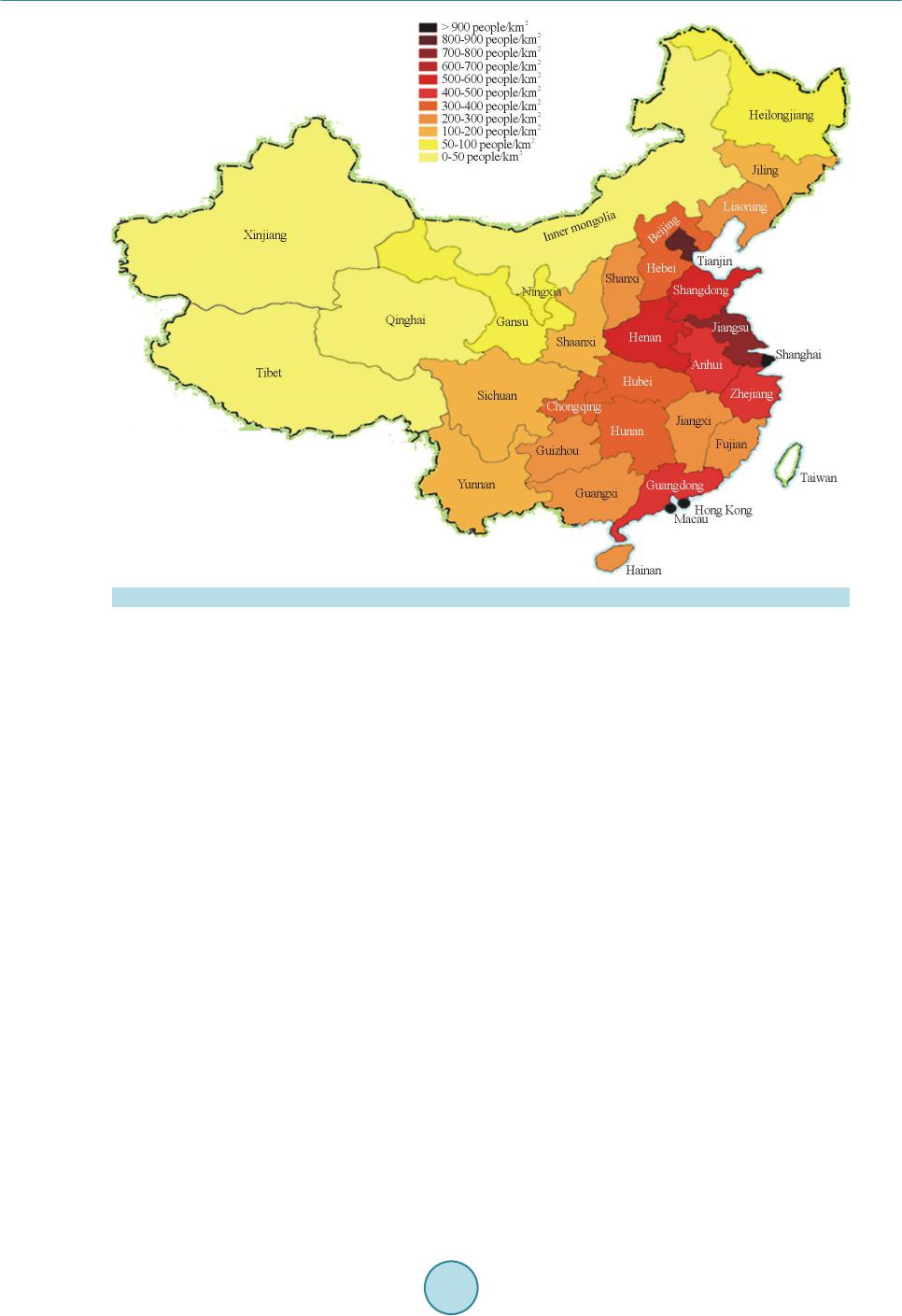 Journal of Geoscience and Environment Protection, 2015, 3, 104-110 Published Online July 2015 in SciRes. http://www.scirp.org/journal/gep http://dx.doi.org/10.4236/gep.2015.35012 How to cite this paper: Li, X. and Qiao, Y.L. (2015) Environment Problems of City Development in China. Journal of Geos- cience and Environment Protection, 3, 104-110. http://dx.doi.org/10.4236/gep.2015.35012 Environment Problems of City Development in China Xin Li1, Yanli Qiao2 1Tianjin Research Institute of Water Transport Engineering, MOT, Tianjin, China 2ENN Intelligent Energy Co., Ltd., Langfang, China Email: xin2li@yeah.net Received 1 May 2015; accepted 25 July 2015; published 28 July 2015 Copyright © 2015 by authors and Scientific Research Publishing Inc. This work is licensed under the Creative Commons Attribution International License (CC BY). http://creativecommons.org/licenses/by/4.0/ Abstract Environmental issues in the process of rapid urbanization are critical to the sustainability of China. Compact cities, characterized by relative high density, mixed land-use and pedestrian-oriented habitation, have been proposed as one solution for sustainable urban planning. However, given the fact that Chinese cities are characterized by high population densities, the applicability of a more compact solution to expanding cities in China remains questionable. Essential to the deci- sion-making is a deeper understanding about the relationship between urban compactness and the sustainable environment of the cities. This study is proposed for an evaluation about the ur- banization and urban development in China’s context from environmental perspective, especially with respect to atmospheric environment, water resources, waste pollution, and noise problems. Keywords Environmental Issues, Rapid Urbanization, Ch ina, S tyl ing, Pollution 1. Introduction Following the initiation of the reform and opening policy, urbanization in China increased in speed [1]. By the end of 2013, population lived in urban areas are 53.7% of the total, a rate that rose from 26% in 1990 [2] [3]. According to official forecast, the urbanization rate will reach 60% by 2020 [4] [5]. Urbanization, in turn, is reshaping both the physical environment and the cultural fabric [6] [7]. Take, for example, the issue of pollution [8]. Huge cities place huge demands on the environment [9]-[11], but high-density living conditions also present opportunities for improving efficiency of energy usage [12] [13]. Accor din g to W or ld B ank ind i cato rs when e valua ti ng the le vel o f ur baniz atio n [14], the cur rent leve l of urb a- nization in developed countries has reached about 80 percent [15], close to the world average of 50% [16] [17],  X. Li, Y. L. Qiao the average level of developing countries was 42%, while China’s leve l of o nly 36 %. Clic k here t o eval uate t he level of urbanization in China is in the lo w to mid-level transition period. 2. Urbanization and Urban Development in China China is the world’s largest developing country, since the reform and opening up, the rapid development of ur- banization [18] [19], but China’s urbanization process is not completed in the case of industrialized carried out [20]. Before the reform and o pening up, indu strializa tio n a nd e cono mic develop ment i s re lativel y backward [21], China’s urbanization development stage is almost at a standstill [22]. China’s urbanization rate increased from 28 percent to 45 percent only 15 years, and to increase by 1% per year rate of increase in 2035 will reach about 75%. China’s urbanization process is much faster than the developed countries in Europe and America [23]. In this regard theo rists and politicians have gi ven great attention (Fig ure 1). Regional imbalances between urban development in China, the overall presentation “ladder” shape [24]. Chi- na is c ur r ently t he ma in ur ba n de vel o p ment in l arge c it ie s, s mal l t o wn s d e vel o p men t is hi ghly une ve n [25], mo st of the small cit y on the structure and f unction but also mee t the require ments, po llution, traffic planning unre a- sonable; although cities can provide more resources and effectiveness, but development of big cities, unreasona- ble structure i ncreasingl y prominent contradiction city needs to provide resources and people’s deterior a tion. The rapid increase in the number of cities, on the other hand, there were many large cities, large cities, and many cities in the contiguous spread from urban agglo merat io ns, be lt. T his is the main fea ture o f Ch ine se urb an spatial structure [26]. A large piece of residential areas, industrial parks, development zones in the city a nd ot her cities New Rising edge. The new industrial space, commercial ecological zones, new living space have e merged, but also spawned the formation of rapid transit network. New newly formed space is bound to expand in the open; some with concentric exp ansion, there ar e axial extensio n, more multi-core expansion, affecting the entire city morphology. China is in the late stages of industrialization and urbanization accelerated development, con- struction and development of a large number of industrial parks and development zones, making the high con- sumption of resources and energy [27], the overall deterioration of the environment has not been fundamentally reversed the trend, the development of unbalanced, uncoordinated and not continuing problem is more promi- nent. 3. Environmental Issues of Urban Development Environment in China Large scale development of China’s urbanization is uneven regional development (Figure 2). Many problems brought about the development process of urbanization have emerged [21]. Urbanization process, a lot of the rural population i nto the ci ties, a nd the i nflux o f urban p opulation s hould e njoy the benefi ts have not bee n pro- tected [22]. In the p ro c ess o f urb a niz ati o n in t he c it y shoul d b e ab le to so lve the emp loym ent p r o b le m ca use d b y the increase of urban population, housing issues, transportation issues [23], education, health problems and in- frastructure issues [28]. But the ability to accommodate a population of each city is limited, almost become satu- rated urban issues in residence, employment, housing, education, health care, pension, insurance, transportation, Figure 1 . Urban population growth in China, comparing with continents and world (%).  X. Li, Y. L. Qiao Figure 2. Population density of China. production and management, and other prominent cultural life is particularly serious [24]. Urbanization in the presence of t his series o f questions, with the reg ulation of national policy, guida nce, there will be ro om for i m- provement. However, the process of urbanization in energy consumption caused by environmental problems have been imminent, more serious environmental proble m in the short term is irreversible process, of particular concern. 3.1. Impact of Urbanization on Atmospheric Environment Urban air pollution is excessive expansion and rapid growth of the economy spawned a more prominent envi- ronmental issues [25] [26]. At present, China’s urban ambient air quality is in heavier overall pollution levels [27]. The main pollutants are dust and sulfur dioxide [29]. Urban air pollution in winter and spring, heavier, summer, autumn light [30]; northern city of dust, dust pollution is heavy [38], heavy southern city of sulfur dioxide pollution, acid rain damage widening [28] [31]. Overall, the northern cities are more important than the southern cities [32]. Meanwhile, with the increasing number of cars in the city [33], environmental pollution caused by auto mobile exhaust has become increasingly serious [34] [35]; the atmosphere is facing the dual pressures of smoke pollu- tion and car exhaust pollution [36]. In some cities, automobile exhaust emissions accounted for 35 percent of urban air pollution, some even more than 50%, to prevent and reduce vehicle exhaust pollution has reached a critical state. Potential danger of photochemical smog caused by vehicle exhaust could erupt at any time [37]. At present, some Chinese large and medium cities in the hybrid vehicle exhaust soot and pollution. In addition, urban heat island effect, urban average annual temperature increase, increase in temperature days, the city is also a fall in atmosp heric visibility outstanding performance deterioration of urban atmospheric envi- ronment [38]. World Urb an Air Qualit y Rep or t 2011 relea sed by the W orl d Health Or ga nization, C hina 31 cap ital cities, t he air quality of the best sea, in 1082 the c ity of all s urveyed ranked o nly 814, ranked No . 978 in t he four mu nici- palities Shan ghai bit, the rest were in 1000 after the city over a ll air quality is po or [39].  X. Li, Y. L. Qiao 3.2. Impact of Urbanization on Water Resources Reduce the amount of water. Water pollution is also a city of over-exp ansio n and r apid econo mic gro wth i n the birth of the environme ntal proble ms [40] [41]. With the increase of urban pop ulation, industrial and agricultur al water use and the amount of water needed for life is also increasing [42] [43]. China is not rich in water re- sources per capita, regional distribution is not uniform [44] [45], and a large inter-annual differe nce during the year is also unpredictable [46] [47]. The existing more t han 600 cities in China, about 400 cities short of water, there are more than 100 cities severe water shortages, water shortages more than 60 million/m3 per year [48]. Urban water shortages caused by overload, the overall function decline [49] [50]. T his is a limited resource, no t only has not been effectively utilized, but often appears wasting water, water pollution phenomenon. More se- rious is irrespo nsible to indiscr iminate dischar ge of industri al and domestic sewage, in recent years, the total na- tional average wastewater enterprises in more than 100 million t per day. Among them, there are more than 80 percent of the wastewater did not get a ny treat ment, or after a certain treat ment, thoug h, but still i n line with t he national emission standards. More than 90% of urban polluted waters, nearly 50% of key urban water do not meet drinking water standards. Indisc riminat e disc harge o f waste water no t only makes t he origi nal co ntamina- tion of rivers and lakes of water, and gave a lot of creatures brought great harm, and therefore around the coun- try more than two thirds of the city there will be a shortage of water. Consequences of urban water shortage in many cities is extensive use of groundwater, making lowering the water table, groundwater space destroyed, lose the ability to regenerate, the city always at risk of land subsidence. 3.3. Impact of Urbaniza ti on on Waste Pollution Garbage polluting the environment is the more prominent urbanization problems [51]. With the urban popula- tion is growing, the amount of waste increases, according to experts, statistics 668 cities nationwide per capita production of 440 kg of solid domestic waste, accounting for more than a quarter of the world total. Now urban lifestyle has been “saving” to “abandon” change, waste production is growing, and at a rate of 8 to 10 percent annual growth, more than the world average growth rate (8.42%). At the same time, waste disposal means gen- erally lag behind, simple incineration, landfill, or even open dumps, causing huge economic losses, aggravated garbage si ege pheno menon, and s econdary pollution, lon g-term difficult to e liminate. 3.4. Impact of Urbanization on Noise Problems Noise problem has been from the peaceful countryside to the bustling city of significant sign [52]. Envir on men- tal noise pollution in China is in addition to air pollution, water pollution, and the third largest environmental hazards. In the city, it has raised to the first major environmental hazards trend [53]. At present, nearly half of China’s urban regional environmental noise pollution levels in the middle 33% of the urban part of light pollution [54]. Living among a wide range of noise, and was widening, traffic noise to disturb the largest living environment, construction noise nuisance is serious. The impact of the urban environ- ment in a variety of noise sources, industrial noise accounted for 8% to 10% [55], about 5% of construction noise, traffic noise is about 30%, or about 46 percent of social life noise. 4. Conclusion Gener ally spea king, the analys is findin gs of this p aper ar e in conj unction with the mainst ream ar guments o f ur- banization and urban development in China. However, the influences of urban compactness on studied envi- ronmental attributes are simply for being much less significant as had been expected. The explanation can be that general enviro nmental quality of any city is usually a function of assorted social, economic, climatic, topo- graphical, a nd institutio nal va riables; the explanation po wer of densit y variables ca n be over whelmed. Also, un- certainties with regar ds to multi-dir ectional intera ctio n of urb an develo p ment variable s, li ke urba n for m, pop ula- tion scope, density and their diversified effects on urban environmental performance bring about the complex- ness from the rela tionship. References [1] Ma, L.J. (2002) Urban Transformation in China, 19 49-2000: A Review and Research Agenda. Environment and Plan-  X. Li, Y. L. Qiao ning A, 34, 1545-1569. [2] Zhang, G., Peng, S., Jing, L., Bai, J., Zhang, X., et al. (2012) Port Construction and Wetland Protection. China Forestry Publishing House, Beijing. [3] Ma, C., Ju, M., Li, H., Zh ang, X. and Cheng, C. (2011) Analysis of Change and Dri vin g For ce in Land Ecosystem Di- versity in Tianjin. Acta Scientiarum Naturalium Universitatis Nankaiensis, 1, 13. [4] Zhang, X., Ma, C., Gu, S., Ynag, J., Song, B., He, X., et al. (2009) Complexity of Ecosystem Dynamics. Acta Scien- tiarum Naturalium Unive rs itatis Nankaie nsis , 42, 99-104. [5] Qiao, Y., Gu, S., Tang, Y., Du, M. and Ga o , Y. (2008) Characteristics of Diffuse Radiation on the Qinghai-Tibetan Plateau. Acta Scientiarum Naturalium Universitatis Nankaiensis, 41, 69-78. [6] Zhang, X., Ma, C., Ch en, W. and Li, H. (2012) Ecological Water Requirement for Wetland Ecological Restoration in Tianjin Binhai New Area. South-to-North Water Diversion and Water Science & Technology, 10, 63-66. [7] Zhang, X., C ao, L. and Caldeira, K. (2013) Energy Switching Threshold for Climatic Benefits. AGU Fall Meeting Ab- stracts, 1, 1095. [8] Ma, C., Zhang, G., Zhang, X., Li , H., Ju, M., Zhou, B., et al. (2012) Modes of Wetland Ecological Restoration in Tian- jin Bin hai New Area. South-to-North Wa ter Diversion and Water Science & Technology, 10, 30-33. [9] Li , Y., Zhu, X., Sun, X. and Wang, F. (2010) Landscape Effects of Environ ment al Impact on Bay-Area Wetlands under Rapid Urban Expansion and Develop ment Poli cy: A Case Study of Lianyungang, China. Landscape and Urban Plan- ning, 94, 218-227. http://dx.doi.org/10.1016/j.landurbplan.2009.10.006 [10] Wang, Z., Zh an, S. an d Zhang, X. (2012) Research on the Filling Problem of Liquefied Natural Gas Ships. Shan xi Ar- chitecture, 38, 273-274. [11] Zhang, X.C., Chen , W.P ., Ma, C. and Z han , S.F. (2013 ) Modeling Particulate Matter Emissions during Mineral Load- ing Process under Weak Wind Simulation. Science of the Tot al E n v i ronm e nt , 449, 168-173. http://dx.doi.org/10.1016/j.scitotenv.2013.01.050 [12] Zhang, X.C., Ma, C., Zhan, S.F. and Che n , W.P . (2011 ) Assessing Powder Emission Risk on Large Open-Air Yard of Coal Energy. Proceedings of the International Conference on Energy and Environmental Science, 11, 3047-3053. [13] Zhang, X.C., Ma, C., C h en, W.P. and Gu , S. (2013) Global Utilization and Development of Wind Energy. Proceedings of the 2nd International Conference on Energy, Environment and Sustainable Development, 608, 584-587. [14] Ma, C., Zhang, X.C., Zhang, G., Chen, W. P. and Gu, S. (2013) Global Utilization of Solar Energy and Development of Solar Cell Materials. Proceedings of the 2nd International Conference on Energy, Environment and Sustainable De- velopment, 608, 151-154. [15] Zhang, X. C. , Ma, C., Zhan , S.F. and Lu, L.B. (2012) Planning and Construction of Eco-City: Theory Application and Case Stu dy. Applied Mechanics and Materials, 174-177, 2408-2411. http://dx.doi.org/10.4028/www.scientific.net/amm.174-177.2408 [16] Zhang, X.C., Ma, C., Chen, W.P. and Zh an , S.F. (2013) Safety Design for Support Structure of Regional Wind System Engineering. Proceedings of the 2nd International Conference on Civil Engineering and Transportation, 256, 1029- 1032. [17] Zhang, X.C., Ma, C., Chen, W.P. and Zhan, S.F. (2012) Safety Management Standard Evaluation System for Port Based on AHP. Proceedings of the International Conference on Remote Sensing, Environment and Transportation En- gineering, Nanjing, 1-3 June 2012, 2425-2428. [18] Gao , Z., Gao, Y., Zheng, Z. and Zhang, X.C. (2009) A Comparative Study of Photosynthetic Characteristics of Cara- gana davazamcii between Plants of Different Ages in Huangfuchuan Basin of Ordos Plateau. Bulletin of Botanical Re- search, 2, 11. [19] Ma, C., Zhang, G.Y., Zhang, X.C. and Li, Y.J. (2012) Application of Multiple Indicators in Environment Evaluation of Coastal Restoration Engineering: A Case Study in Bohai Bay in China. Applied Mechanics and Materials, 170, 2228- 2232. [20] Zhang, X.C., Chen, W.P., Ma, C. and Z h an , S.F. (2012) Modeling the Effect of Humidity on the Threshold Friction Velocity of Coal Particles. Atmospheric Environment, 56, 154-160. http://dx.doi.org/10.1016/j.atmosenv.2012.04.015 [21] Zhang, X.C., Myhrvold, N.P. and Caldeira, K. (2014) Evaluatin g the Climate E ffects o f Natural Gas vs. Co al Elect ric- ity Generation. Proceedi ngs of the American Geophysical Union Fall Meeting, S an Francisco, 15-19 December 2014, 625. [22] Meng, W.Q., Ma, C., Ju, M.T. , Li, H.Y. and F en g , H. (2008) Dynamic Calculat ion and Analysis o f Eco-Footprints of Tianjin City in the Past Two Decades. J our n al of Safety an d Env ironment, 8, 67-71. [23] Meng, W.Q., Li, H.Y., Ju, M.T. , Ma, C., Shao, C.F. and Chang, H. (2008) An Overview of Restoration and Recon- struction of Damaged Ecosystem in Europe. Bulletin of Soil and Water Conservation, 28, 201-208.  X. Li, Y. L. Qiao [24] Meng, W.Q., Li, H.Y., Ju, M.T. , Wu, X. and Ma, C. (2008) Integrated Assessment of Urban Green Space Based on Citizen Requirement of Tianjin. Urban Environment & Urban Ecology, 6. [25] Chen, J., Zh an, S.F. and Zhang, X.C. (2009) Study on Construction Development and Theories of Green Port. Journal of Transport Information and Safety, 27, 198-202. [26] Ma, C., M eng , W.Q. and Li, H.Y. (2006) Discussion on the Use of Ecological Concept. Sichuan Environment, 25, 54- 58. [27] Zhang, X. and Caldeira, K. (2015) Timescales and Ratios of Climate Forcing Due to Thermal versus Carbon Dioxide Emissions from Fossi l Fuels. Geophysical Research Letters, 42. [28] Wang, J.F., Ma, L., Zhan, S.F., Zhang, X.C., P eng, S. T. and Ma, C. (2009) Effects of Moisture on Threshold Velocity of Coal Dust. Journal of Waterway and Harbour, 30, 209-212. [29] Ma, C., Ju, M.-T., Zhang, X.C. and Li, H.Y. (2011) Energy Consumption and Carbon Emissions in a Coastal City in China. Procedia Environmental Sciences, 4, 1-9. http://dx.doi.org/10.1016/j.proenv.2011.03.001 [30] Ma, C., Zhang, X.C., Zhang, G., Ju, M.T. , Zh ou, B. and Li, X. (2012) Application of DPSIR Framework in Environ- mental Impact Assessment for Port Planning. China Environmental Science, 32, 107-111. [31] Ma, C., Zhang, G., Zhang, X.C., Zhou, B. and Mao, T.Y. (2012) Simulation Modeling for Wetland Utilization and Protection Based on System Dynamic Model in a Coastal City, China. Procedia Environmental Sciences, 13, 202-213. http://dx.doi.org/10.1016/j.proenv.2012.01.019 [32] Ma, C., Zhang, G., Zhang, X.C., Zhao, Y. and Li , H. (2012) Application of Markov Model in Wetland Change Dy- namics in Tian jin Coastal Area, China. Proce di a Env ironme ntal Sc ienc e s , 13, 252-262. http://dx.doi.org/10.1016/j.proenv.2012.01.024 [33] Zhang, X., Myhrvold, N.P. and Caldeira, K. (2014) Key Factors for Assessing Climat e Benefits of Nat ural Gas versus Coal Electricity Generation. Enviro nmental Research Letters, 9, Article ID: 114022. http://dx.doi.org/10.1088/1748-9326/9/11/114022 [34] Zhan, S.F., Ma, C., Zhang, X.C., Chen, W. and He, Q. (2011) Evaluating Dust Emission Risk for Coal Energy Han- dling of Large Stacker on Wind Tunnel. Energy Procedia, 11, 3054-3059. [35] Zhang, X.C. , Myhrvold, N. and Caldeira, K. (2015) Assessing Climate Benefits of Natural Gas and Coal Electricity Generation. EGU General Assembly, Volume 17, EGU2015-13925. [36] Zhang, X.C., Gu, S., Zhao, X., Cui, X., Zhao , L., Xu, S., et al. (2010) Radiation Partitioning and Its Relation to Envi- ronmental Factors above a Meadow Ecosystem on the Qinghai-Tibetan Plateau. Journal of Geophysical Research- Atmospheres, 115. [37] Zhang, X.C., Ma, C., Chen, W.P. and Zhan , S.F. (2012) Urban Atmospheric Environmental Health Risk Assessment on Landscape. Proceeding of the Conference on Urban Environmental Pollution 2012: Creating Healthy, Li veable C i- ties, Amsterdam, 17-20 June 2012. [38] Zhang, X.C., Chen, W.P., Ma, C., Zhan, S.F. and Jiao, W.T. (2012) Regional Atmospheric Environment Risk Source Identification and Assessment. Envir onmental Sc i e nc e , 33, 4167-4172. [39] Han, G., Zhan, S.F ., Zhang, X.C. and Ma, C. (2009) In fluence Fact ors and M athematical M odel of Co al Dust Particles Thre s hol d Vel oc it y. Jou rn a l of C hi n a Co al Society, 34, 1359-1363. [40] Zhang, X.C., Ma, C., Zhan, S.F. and Chen, W.P. (2012) Evaluation and Simulation for Ecological Risk Based on Emergy Analysis and Pressure-Stat e-Response Model in a Coastal City, China. Procedia Environmental Sciences, 13, 221-231. http://dx.doi.org/10.1016/j.proenv.2012.01.021 [41] Zhan, S.F., Zhang, X.C. , Ma, C. and Chen, W. P. (2012) Dynamic Modelling for Ecological and Economic Sustainabil- ity in a Rapid Urbanizing Region. Procedia Environmental Sciences, 13, 242 -251. http://dx.doi.org/10.1016/j.proenv.2012.01.023 [42] Ma, C., Li, H., Meng, W., Zhang, L. and Zhang, X.C. (2007) Use of Sustainable Landscape Design on Protection in Tianjin Coastal Wetlands. C hi n a Populat i o n, Resources and Environment, 17, 314-317. [43] Zhang, X.C., C hen, W.P., Ma, C., Zhang, G. and Ju, M. (20 12) Assessment Method for Regional Environmental Risk Based on Pressure-State-Response Model. C hina Env ir o nm e ntal Sc ie nce, 32, 84-87. [44] Ma, C., Meng, W., Ju, M., Li, H., Zhang, X.C. and Hao, C. (2008) Dynamic Assessment of China’s Sustainable De- velopment Possibility Based on the Eco-Environmental Footprint during the Period of 1997-2006. Journal of Safety and Environmental, 8, 75-80. [45] Ma, C., Zhang, X.C., Zhang, L., Ju, M., Li , H. and Mo , X. (2010) Modified Sustainable Development Model of Tianjin Municipality Based on the Eco-Footprint Method. Journal of Safety and Environmental, 10, 127-131. [46] Ma, C., Zh ang, G., Zhang, X.C. , Zhou, B. and Jiang, W. (2012) Water Resource M anagement for Wetland Restor ation Engineering in Tianjin Coastal Area in China. Proceedings of the International Conference on Energy and Environ-  X. Li, Y. L. Qiao mental Protection, 518, 4333-4336. http://dx.doi.org/10.4028/www.scientific.net/amr.518-523.4333 [47] Ma, C., Sun, Q., Zhou, Y., Li, H. and Zhang, X.C. (2007) TWINSPAN Classification and Selection of Alfalfa Culti- vars. Prataculture & Animal Husbandry, 24-27. [48] Ma, C., Zhang, X.C., Chen, W.P., Zhang, G., Duan, H., Ju, M., et al. (2013) China’s Special Marine Protected Area Policy: Trade-Off between Economic Development and Marine Conservation. Ocean & Coastal Management, 76, 1- 11. http://dx.doi.org/10.1016/j.ocecoaman.2013.02.007 [49] Hu, Y., Gu, S., Jiang, S., Zhang, X. C. , Li, J., Gao , Y.B. and Qi ao , Y.L. (2010) Effect of Different Light Quality on Fruit Quality of “Darselect” S t r a wb err y (Fragaria × ananassa Duch.). Journal of Sichuan Agricultural University, 28, 164-168. [50] Ye, S.-L., Ma, C. and Ju, M.-T. (2009) Standardization Framework of Marine Sustainable Development Evaluation System. China Stan dardization, 36, 16 -20. [51] Zhan, S., Zhang, X.C. and Ma, C. (2009) Coal Classification Based on Environmental Protection and Burning Quality. Journal of China Coal Soc iety, 34, 1535-1539. [52] Zhang, G., Zhan, S. an d Zhang, X.C. (2009) Theory and Technology for Aerosol Pollution Control in Port. China Communic a ti on Pre s s , Beijing. [53] Yeh, A.G.O. and Wu, F.L. (1996) The New L and Develo p ment P rocess and Urb an Devel opment in Ch in ese Cit ies. In- ternational Journal of Urban and Regional Research, 20, 330-353. http://dx.doi.org/10.1111/j.1468-2427.1996.tb00319.x [54] Wang, Y.P., Wang, Y. and Wu , J. (2009) Urbanization and Informal Development in China: Urban Villages in Shenz- hen. International Journal of Urban and Regional Research, 33, 957-973. http://dx.doi.org/10.1111/j.1468-2427.2009.00891.x [55] Verburg, P.H., Schot, P.P., Dijst, M.J. and Veldkamp, A. (2004) Land Use Change Modelling: Current Practice and Research Priorities. GeoJournal, 61, 309-324. http://dx.doi.org/10.1007/s10708-004-4946-y
|